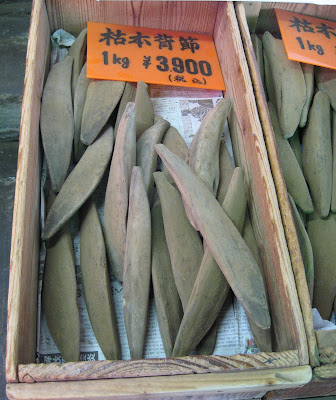Dissatisfied with my dashi, I journeyed to Izumo.
OK, that's not entirely true, but I like the sound of it. And it's not entirely false either. Once I had felt I had gotten the knack of making dashi, as detailed in Quest for Katsuobushi, I tested my new skill on Marta's friend Keisuke and his family. The soup I made was just as described before: dashi made from kombu and katsuobushi, salted to taste, with small chunks of soft tofu and thin slivers of Japanese green onion. Keisuke said the broth was nice, but then ever so politely wondered why there wasn't any miso in it, or rice alongside.
These were good questions, but it wasn't that I hadn't thought of these things. Katsuobushi, according to the food scientists, has one of the most complex flavor spectra of any food. Wouldn't it be a shame to mask its depth of flavor with miso, itself no slouch in the complexity department? And rice. I don't have any problem with rice. It's good when made well, but why not focus on less humble foods when you're aiming to impress?
Why not? Because "dashi is deep". It's not simply about its large number of different flavor molecules, its "lactic acic and amino acids, peptides, and nucleotides, . . . , pungent phenolic compunds, . . ., nitrogen- and sulfer-containing carbon rings, . . ., flowery, fruity, green notes" [McGee again]. It's about much more than this, as I was to learn.
Let me begin by saying that katsuobushi is not quite as hard to find in Japan as I had thought, even though Keisuke had told me that I was the first person he'd ever seen holding it. Indeed we saw katsuobushi our very first day, simply because we happened to visit Tokyo's Tsukiji, the biggest fish market in the world:
Surprisingly, whole katsuobushi was more expensive by weight than flaked. We conjecture that's because the flakes are made from more unattractive specimens. Sometime later, I turned on the TV to see a cooking show wherein they stewed 5mm (!) slices of katsuobushi until soft, then cooked them with bitter melon. Toward the end of our trip, we saw katsuobushi again in Kyoto's Nishiki gourmet shopping district.
My first katsuobushi, however, had come from Izumo, and Izumo seemed to be a good starting point for an eastward bike trip from rural to urban Japan. No doubt e-dashi's Hiromi and Haruo, living in Japan's least populous Shimane prefecture, were doubtful that we'd follow through when we said, "Hey, we'll be in Japan. Maybe we'll drop by." But then, we had surprised them already: We learned that ours was the first order, in their 10 years on the web, from gaijin.
Given our novelty, maybe we shouldn't have been entirely surprised that we were greeted by more than a simple hello. But then I don't think there was any reason to expect the ensuing full-court press of hospitality. Marta has already described part of it. Here is the rest:
After visiting Izumo taisha, we were brought to e-dashi's store, which is built into the front of a 100-year-old house. The inside is a study in restraint. Unlike in America's overflowing aisles, the stock is arranged to fit the room, like museum exhibits. There was everything needed to make good dashi: katsuobushi, of course, but also (giant--see below) kombu, mushrooms, small dried fish, and---here I finally see one---a katsuobushi dezuriki, the plane traditionally used to make the flakes. I was interested, of course. First, though, lunch to a very good tempuraya. Before we leave, Hiromi places two pieces of kombu to cold-steep in a pan of water.
When we return, I learn about the dezuriki. Like other Japanese planes, it consists of a block of oak with a slot cut into it, just large enough so that the iron can be wedged in. The block then fits into the drawered box that catches the flakes.
The iron is made of two layers of metal, one soft and one hard. The soft layer gives support to the harder cutting edge, and makes it easier to remove metal when sharpening. This is important because the cutting steel in Japanese tools is considerably harder than in western cutlery. The iron is set into the oak at a rather shallow angle---10 degrees less, I'd say, than the Sheffield plane I used before. The smaller angle means that each shaving bends less as it's removed. In woodworking, we don't care at all about the shavings; only what's left counts. Here they're important, aesthetically at least. If shavings bent as they are removed, they will become opaque and rough. Perhaps the soup doesn't care, but if you want the flakes to look pretty dancing, better they be shiny.
Here Haruo shows me how to use the plane, which he had restored himself:
Here Haruo demonstrates. He was much more fluid than I.
Here one must be careful not to make finger shavings also---the blade is razor sharp, or sharper ("Razor sharp isn't sharp!" once insisted a guy at Japanwoodworker).
Haruo also shows us an intermediate stage of katsuobushi. This piece has picked up a layer of char from weeks of exposure to smoke. This char will have to be removed before the piece is inoculated with mold.
We are now ready for the dashi lesson. Heat the water. As soon as bubbles start to appear, remove the kombu. Heat the water to boiling, and add the flaked katsuobushi, 5 to 7 grams per cup of water.
Remove from heat and let steep until the flakes sink to the bottom. Strain.
What I didn't do before: Add equal parts red and white miso.
An aside about miso: Miso is a fermented mixture of soybean and rice. White miso has about 4 parts rice to 1 part soybean, and ferments for a month or so. Red has soy-to-rice ratio anywhere from 1 to infinity. It ferments much longer, for six months or so. Miso is much like cheese, in that it is cultured many ways. Earlier, Yokohama's Hideo and Yoko had us try red miso from Nagoya, which was much earthier than others.
To add miso to dashi, one typically emulsifies it inside a spoon with some of the dashi. Traditionally there was a special spoon just for this purpose, but any will do.
Now reheat the dashi to just below boiling, and add whatever else you have planned. Here, Hiromi is using a type of tofu.
The finished soup:
This soup was, not surprisingly, very good. However, the miso was masking some of the smokiness of the katsuobushi and the sea smell of the kombu. How was I to accept that the the most hard-to-find and complex ingredients were playing the supporting role in this soup?
This wasn't to be our last taste of dashi in Izumo. When Hiromi prepared for sushi handrolls for dinner, she cooked the rice in dashi. Again, very good, but a supporting role for the katsuobushi.
The attentive and faithful reader of this blog may have noticed a resemblance between the dezuriki above and the one shown earlier alongside miso soup and dashi rice in Quest for Katsuobushi: Intermezzo Anacronistico. Before we left the house that night, Hiromi asked two questions from a printout. First, "Are used goods okay?" Sure, everything I own is used. Second, "Would you like to have the dezuriki?"
Flash forward to last August. The dezuriki had arrived by mail from Izumo, and I was trying put together a set of return gifts that would suitably express how much I appreciated their profound generosity. We had tried to teach Hiromi and Haruo's sons a bit of English while waiting for dinner, and they had said they liked the manga Dragonball Z, so I went to a Berkeley comic store to look for the English version. On one shelf, there was a tag from the employees recommending a manga called Oishinbo, about a group of foodies traveling Japan assembling the "ultimate menu". This popular manga had had a long run starting in the 80s. The English translation was a compilation, "A la Carte", of episodes arranged into a "full-course manga meal". First course: "The Secret of Dashi." Well well.
In this episode, our hero Shiro rescues the stand-in chefs at a Tokyo keiseki restaurant, who are struggling to make a dashi that will be accepted by Shiro's demanding father, who happens to be in a different room in the same place. Shiro's dashi procedure is roughly the same as Hiromi's, with some differences: Instead of letting the kombu soak, Shiro first gently rinses it under the tap water, then slides it through the hot water in the pan in just one pass. (The footnotes call this technique "hikidashi kombu"--to draw forth the kombu.) Shiro seems to reduce the steeping time for the katsuobushi flakes as well: He claims that boiling would draw out the fish flavor, and one wouldn't want this fish flavor to compete with that of the fish served in the soup. The manga is describing just what we had in Kyoto.
The characters say the dashi is very subtle, but with a fine flavor. That is, even when there is no miso, the dashi must still be in the background. When the intensity of the mixins goes down, so must the dashi.
I asked Hiromi about this by email. "The professional uses dashi properly by the dish. Dashi is deep, and interesting," she wrote.
In summary, there is no one way to make dashi, but whatever you do, dashi can only be the soup base, it seems.
To understand why dashi must be the background, I had been thinking about the history of katsuobushi. Like preserved foods the world over, it was developed in a time before refrigeration. Living off the sea, the early Japanese had a mixed blessing. The waters, when generous, supplied a wondrous variety of fish. But when the seas were rough, the schools of fish had moved on, and the supply drew short, what was left quickly spoiled in the heat. Rice supplied neither a complete set of proteins nor flavor that could be enjoyed indefinitely. So, I figured, the Japanese learned to turn fish to wood, so that it could enhance the flavor of rice in times of scarcity. To bring these flavors to the forefront would be prodigal: they are there only to help us enjoy what we have, to help us through the tough times.
But I figured wrong! Other sources tell me that rice was just as unavailable to the early, poor Japanese as fish, perhaps more so. The least expensive grain was instead wheat. That, I guess, moves miso up in prestige. Does that explain everything, then? Miso and katsubushi are coequal partners? "Dissatisfied with my miso, I journeyed to Nagoya . . . " I like the sound of that.
Wednesday, November 18, 2009
| [+/-] |
Quest for Katsuobushi, II: "Dashi is Deep" |
Subscribe to:
Comments (Atom)






